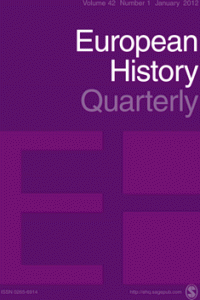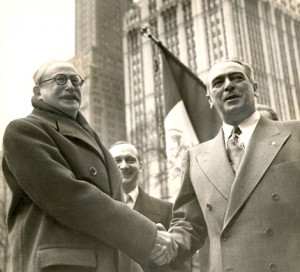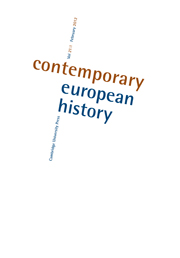 A new Issue of European Review of History: Revue europeenne d’histoire Volume 19, Issue 2, 2012 has been published and contains the following articles:
A new Issue of European Review of History: Revue europeenne d’histoire Volume 19, Issue 2, 2012 has been published and contains the following articles:
‘In carcere; ad dupplicium’: Jesuit encounters in prison and in places of execution. Reflections on the early-modern period. Paul John Shore
Jesuits of the early-modern period had, as a major aspect of their missions and ministry, encounters with prisoners and with those condemned to execution. The Jesuit experience of these encounters was profoundly influenced by the Spiritual Exercises of Ignatius of Loyola, undertaken by every Jesuit. In these exercises the retreatant is required to visualise the physical sufferings of Christ. During the late seventeenth and early eighteenth centuries, Jesuits were closely connected, from several perspectives, with the imprisonment and execution of scores of individuals. While many of the leading Jesuit theoreticians of the time, such as Roberto Bellarmino, supported the right of the secular state to exercise capital punishment, a tension persisted between the idea of common humanity expounded in the Spiritual Exercises and the role of the Jesuits as supporters of the Habsburg dynasty that conducted these public executions. This essay explores the Jesuit encounter along the eastern and northern Habsburg peripheries and on the ‘frontiers of faith’ with prisoners and the condemned, utilising archival materials, as a contribution to the intellectual history of the Jesuits and to the cultural history of the region.
Transurban interconnectivities: an essay on the interpretation
of the revolutions of 1848. Claus Møller Jørgensen
This essay discusses the interpretation of the revolutionary situations of 1848 in light of recent debates on interconnectivity in history. The concept of transurban interconnectivities is proposed as the most precise concept to capture the nature of interconnectivity in 1848. It is argued that political models circulating on a European scale at the time provided the ‘knowledge resources’ that were appropriated by urban political activists across Europe. These circulating resources were appropriated by political activists as means of political mobilisation in their particular local urban context. It is argued that circulating political communication accounts for similarities with respect to political agenda, organisational form and political repertoire evident in urban settings across Europe. This argument is supported by a series of examples of local organisation and local appropriations of liberalism, radicalism and nationalism in 1848. In the concluding paragraph, the limitations of the notion of urban–rural interconnectivity are discussed in order to clarify the nature of transurban interconnectivity.
Artur Hazelius and the ethnographic display of the Scandinavian peasantry: a study in context and appropriation. Daniel Alan De Groff
Artur Hazelius (1833–1901), founder of the Nordiska Museet and the Skansen Open-Air Museum, was a pioneering figure in the practice of ethnographic display in Europe. Hazelius achieved Europe-wide recognition following his presentation of Swedish and Scandinavian peasant ethnography at the Paris Universal Exposition of 1878, where his displays were reviewed positively in the international press. This paper argues that the significance of the Hazelian ethnographic project was embedded in overlapping contextual frames with centres in Stockholm and Paris. If the displays most readily spoke to a general concern with the decline of traditional life as rooted in the countryside, they arguably took on other, different and occasionally conflicting meanings as they were moved from one exhibitionary context to another. Whereas in Stockholm the ethnographic displays were inscribed in the conciliatory rhetoric of Scandinavism, the exhibitionary setting of the exposition universelle imposed an interpretative frame defined by the logic of a competitive nationalism. For Nordic audiences, the scenes reflected the positive historical significance of the peasantry in the unfolding narrative of Scandinavian political modernity; for the French audience, however, those same scenes were either applauded for their life-likeness or seen as reflective of the ethnographic richness of the ‘kingdom of Sweden’.
French antimilitarism before World War I: Gustave Hervé and L’Affiche Rouge of 1905. Michael Burt Loughlin
Gustave Hervé’s political emergence occurred amidst the Dreyfus Affair. This accelerated his radicalisation. By 1901 he attained notoriety for an apparent image of the tricolour on a dungpile. Soon, his antimilitarist movement called Hervéism attempted to unite the revolutionary Left. After socialist unification, Hervé led the most extreme faction and created a weekly newspaper, La Guerre sociale. In 1905 he joined the Association Internationale Antimilitariste (AIA) which issued a poster based on his ideas. His experience with the AIA presaged several transformations on the French Left. Before 1914 Hervé was a strident voice within European socialism, advocating revolutionary means to prevent war. Years of incendiary campaigns failed to implement his ideas. Despite his dedication, the quixotic Hervé grew frustrated with leftist divisions. His disillusionment arose from a naive reading of an anachronistic revolutionary tradition. Hervé’s sincere, yet romantic and eclectic, socialism exhibited atavistic features. Before the war Hervé rallied to ’la patrie en danger’; in 1919 he created a French national socialist party. Such shifts have been tied to Fascism. Though some recent scholars have stressed the dangers posed by antimilitarism, this article documents a more ambiguous picture of Hervé’s experience with the AIA and his later antimilitarist activities.
Science as propaganda: Swedish scientists and the co-production of American hegemony in Sweden during the cold war, 1953–68. Michael Nilsson
This article takes a close look at how the United States used the funding of scientific research in Sweden as a hegemonic and propaganda tool in the 1950s and 1960s. It shows that non-aligned Sweden functioned just as much as a node in the international science network set up by the Americans after the Second World War as did the North Atlantic Treaty Organization (NATO) countries. These funds were awarded mainly to an elite network of prominent Swedish scientists. The article sheds interesting light on the controversies of such funding in Sweden during the cold war and adds important knowledge about Swedish–American relations during the cold war. The article argues that this Swedish scientific elite co-produced US hegemony in Sweden by actively seeking out American military funding and by making use of it. It also argues that US funding was intended to portray the United States as an altruistic patron of science in the world and thus serve American propagandistic purposes as well.
New models, new questions: historiographical approaches to the Romanian Holocaust. Roland Clark
This essay surveys the historiography on the Romanian Holocaust, focusing in particular on four monographs published by Western historians within the past five years. Earlier research was limited both empirically and theoretically, and these works suggest new research paradigms and raise new questions about the genocide in Romania during the Second World War. Dennis Deletant assesses the rule of General Ion Antonescu in light of his responsibility for the Holocaust and attempts to explain why the General began and ended the Holocaust when he did. Vladimir Solonari argues that the Holocaust should be read in the context of plans for ethnic homogenisation which were implemented when the opportunity presented itself in 1941. Jean Ancel examines the expropriation of Jewish property and shows that, among other things, the Romanian perpetrators were motivated by a desire to enrich themselves at the expense of the Jews. Finally, Armin Heinen reads the Holocaust by looking at how different groups of perpetrators used violence and attempts to recreate the logic that shaped their actions. In addition, the essay discusses Holocaust denial, survivor memoirs and the state of primary-source collections on the Romanian Holocaust.

 A new issue of
A new issue of 






